People
The People Are Like a River
Sometimes the tribe was nomadic and traveled with their animals to the best places to graze and drink. Other tribes settled villages, towns and sometimes cities. Between these towns, trade routes developed. Some routes were over land; others were traveled by river or sea.
People traveled on routes across North Africa when the great Sahara desert was still a wet region. When the land dried and no longer produced crops, overland trading became very difficult. Although people had pack animals, such as cattle horse, and oxen, travel was not easy. These animals could not journey the great distance between each oasis.
In about 300 AD, the Arabian camel was brought to Africa and became the “ship of the desert.” The camel stores fat in its hump and water in its stomach, which allows it to travel up to ten days without fresh water—twice the distance of an ox or a horse. All of a sudden trade was much more dependable.
They traded crops, such as salt, spices, rice, wheat, barley, millet, olives, yams, and sorghum. Goats, fish, cattle, and fowl were some of the livestock bought and sold. People also traded copper, bronze, iron and gold. The metals were useful for making tools, coins, decorations, and weapons.
Each tribe had its wise elders and priests. Many were women but most were men. They would lead the tribe, and if they grew very powerful they were considered kings or queens. People considered them related to the gods. They often organized the building of religious temples and dams and assembled armies to defend their families. Their subjects often paid taxes to pay for these things.
Although some of these kingdoms did not last long and were replaced by others, a few lasted thousands of years. The rule of one king’s family for several generations is called a dynasty. There have been a few African kingdoms that have extended for several dynasties. As other cultures began to grow strong all over the Mediterranean other kingdoms began to push their way into Africa. Small tribes grouped together to fight off the invaders, such as the Greeks, Phoenicians, and Romans






Languages & Religion
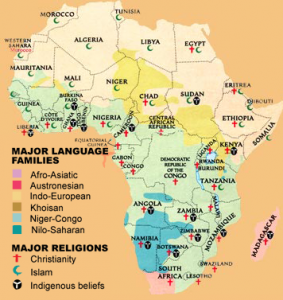
More than 1,000 different languages are spoken in Africa. Although most countries in Eastern and Southern Africa have adopted colonial European languages for official government business, most people speak indigenous or local languages.
In Namibia, people may speak English, Afrikaans, German, Oshivambo, Herero, or Nama. In Tanzania, people can speak English or Swahili.
Due to their colonial pasts, the majority of the countries in West Africa have adopted French, English, Spanish, or Portuguese as national languages. The majority of each countries’ inhabitants, however, also speak one or more indigenous languages. Cameroonians may speak one or more of 24 different languages, in addition to French or English.
Yoruba, Hause, and Igbo are some of the nearly 400 native languages of Nigeria.
Most people in the North African countries speak Arabic and follow Islam. In some parts of North Africa, however, people are multilingual and speak several languages. For example, the official languages of Chad and Djibouti are Arabic and French.
In Ethiopia, people may speak one or more of 70 unique languages or 200 different dialects. A dialect is a form or variety of a spoken language.
Religion:
Most people in the fourteen independent countries in North Africa are Muslim. The religion they believe in is called Islam. Muslims pray to their god Allah and his prophet Muhammad five times a day facing the city of Mecca. A prophet is someone who is believed to speak for a god. The Koran is the Muslim holy book.
In African countries south of the Sahara Desert, people follow many different religions. Some are Muslim, although the majority of the people are Christian. Missionaries from other parts of the world brought Christianity to many countries in Africa. Some people, however, choose to follow ancient religions and believe that natural spirits and ancestors affect everyday life.
Culture
The music, art, literature, and cultural practices of Africa have provoked interest and respect throughout the world. The old belief that Africa is somehow childlike in its cultural development has been denounced as people become more familiar with the rich traditions of the continent.
The material and inherent value of African art steadily increases in the world market. The music and literature of these peoples have found their way into houses and classrooms around the globe. We are beginning to learn through the works of scholars, film makers, and writers that Africans can teach us much more than we can show them.

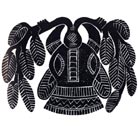
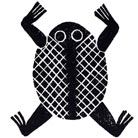

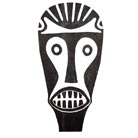

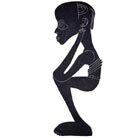

Tribe
People who belong to a common ethnic group may share customs, languages, or a common history. Tribal affiliations are a source of unity and pride for many Africans.
In Mauritania, the Moors are one distinct ethnic group. Moors are people of mixed Arab and Berber heritage. Citizens of Senegal may belong to one of the following tribes: Wolof, Fulani, Serer, Toucouleur, Diola, or Mandigo, among others.
Over 60 ethnic groups co-exist in Burkina Faso. One of these groups, the Fulani, also live in Senegal and Cameroon. Some of the 70 tribal groups that live in Kenya are the Kikuyu, Luhya, and Kalenjin. The Masai people are perhaps the best known to non-Europeans. On the island of Madagascar, 18 different tribes speak Malagasy and French. In Swaziland, Swazi, Zulu, Tsonga-Shangaan, and Europeans live side by side.





Statistics
In addition to being known for its beautiful environments, exotic wildlife, and diverse cultures, Africa has the dubious distinction of having some of the poorest nations, largest populations, and harshest living conditions in the world.
Despite its trove of natural resources, the yearly incomes of Africans are some of the lowest in the world. Nearly half of its people live on less than a dollar a day. Conflicts, harsh environments, and corrupt governments have devasted economies, forcing countries to borrow for goods and fuel.
Ironically, better health care in recent decades has caused further problems in Africa. The population of the continent is approximately 800 million, and these increasing numbers have endangered the environment and strained already weakened governments.
All contributions are tax deductible.



